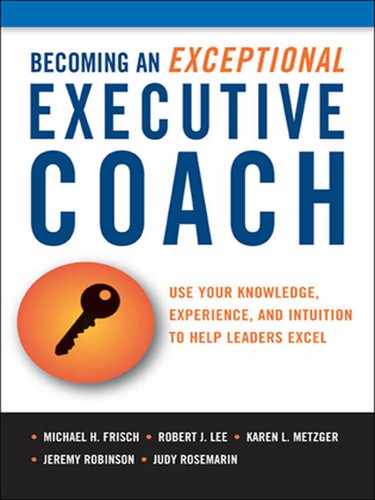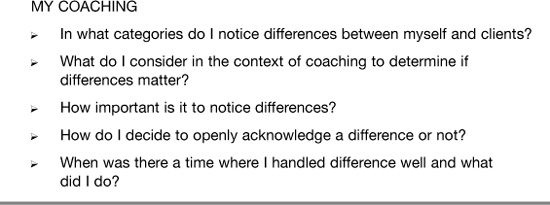CHAPTER
16
Differences
FOR MOST PEOPLE, SIMILARITIES, EVEN SUPERFICIAL ONES, MAKE INTERPERSONAL CONNECTIONS EASIER. WE TEND TO FEEL SAFER WITH WHAT IS FAMILIAR. ON THE OTHER HAND, DIFFERENCES, BOTH OBVIOUS AND SUBTLE, CAN BE VERY enlightening to explore. This is particularly true in coaching. Differences between your clients and their colleagues with regard to background, preferences, interpersonal style, and other variables often figure into the development challenges of your clients. Differences between the coach and the client also can be relevant to the progress made in coaching. It is important to help clients avoid overemphasizing similarities while ignoring relevant differences.
Traditional diversity categories that organizations use for various inclusion initiatives include:
![]() Ethnicity/Race
Ethnicity/Race
![]() Gender
Gender
![]() Religion
Religion
![]() National Origin
National Origin
![]() Disability Status
Disability Status
![]() Sexual Orientation
Sexual Orientation
These categories, however, are actually a subset of the much larger group of differences; there are many other ways in which your clients can differ from their colleagues or we, as coaches, may differ from our clients. For example:
![]() Age
Age
![]() Education (both level and field of study)
Education (both level and field of study)
![]() Work Experience
Work Experience
![]() Interests
Interests
![]() Problem-Solving Style
Problem-Solving Style
![]() Interpersonal Style
Interpersonal Style
![]() Income/Status
Income/Status
Since coaches work at the level of the individual, it is important for you to consider the possible impact of all relevant differences that may exist between you and your client and within your client’s work world. If you focus only on the usual diversity categories you may miss important challenges facing the client.
Coach-Client Differences
You and your clients are likely to differ on one or more observable characteristics. Some clients may comment indirectly on your characteristics as compared to their own (e.g., “This business attracts a very young employee population,” or “Maybe you can help me understand the women on my team”). Most will not. Instead, it is up to you to observe differences, especially during initial coaching meetings, and consider the implications of those differences. How do you feel about differences between yourself and the client? How might those differences inform or distract from the focus of the coaching? What are the big differences? What are the small ones? To the extent that observable coach-client differences may have implications for coaching, the responsibility is yours to put them on the table and discuss them with your client.
For example, you may decide it is important to ask minority clients how they feel about working with you if you are a nonminority coach, or how an older client feels about working with a younger coach. First, you must notice differences to consider the relevance of pointing them out and discussing their implications for your coaching relationship. If you feel that the difference may be of concern to your client, tactfully inviting discussion about it would be consistent with your coaching role.
Among the less visible differences that coaches need to be aware of are those involving preferred learning, interpersonal, and problem-solving styles. For example, your clients may be more concrete or short term in their thinking than you are. Differences such as these may generalize to issues in the client’s work context (e.g., a very logical manager leading creative direct reports). Even when such differences do not emerge directly, coaches usually take responsibility for tailoring their approaches to suit their clients’ preferences. For example, when coaching a client who is very fast-paced, you might shorten your explanations, emphasize quick wins, and deal with immediate pressures. On the other hand, this adjustment would not be helpful with a client who thinks in more strategical and longer-range terms.
Both differences and similarities between coach and client can occasionally influence how clients are matched with coaches. A client may select a coach based on a preference for a similar age or industry background. On the other hand, clients sometimes seek a coach who is different from themselves when a point of difference has implications for their learning. For example, a client might want to learn to improve relationships with a particular age group or race and may choose someone from that group for the coach role. In these cases, coach-client diversity becomes especially compelling when there is a direct application to the client’s work effectiveness. A discussion of differences between coach and client can be an honest, safe forum for the client to explore issues and obstacles in working with differences affecting professional performance.
The Coach’s Responsibility
It is important to heighten your self-awareness and insight about the possible effects of differences in your relationships. We, as coaches, tend to believe that we are more accepting than we really are, or we gloss over differences by latching onto superficial similarities with clients, just as most people do. Feeling discomfort about differences or the reverse—experiencing an excessive pull toward collegiality with clients—are indications that it would be helpful for you to explore those reactions with a mentor or case supervisor. Even when the similarities or differences between you and the client have contributed to the sponsor or client choosing you as a coach, the differences may be worthy of discussion.
Use Figure 16-1 to become more self-aware about your reactions to differences.
Figure 16-1. Self-assessment about differences

Differences in the Workplace
In the course of discussing felt needs, clients may point out differences they have noticed at work. These may run the gamut from traditional differences of age, gender, race, nationality, religion, and sexual orientation to some differences that are less common, such as organizational and cultural differences within a newly merged company. These differences could occur between your client and specific individuals or between departments and teams.
Your client may want help with how to address differences that may be triggering tensions among individuals or subgroups. Coaching is an excellent forum for the clients to consider the implications of the many differences that may exist in their organization. You are empowered to raise questions about those differences, especially if you believe that the client would be a more effective leader with more overt attention paid to them. While you are not a diversity consultant, raising your client’s awareness about difference issues within the organization may fit directly into the client’s development plan.
Coaching to Support Diversity Initiatives
Despite a significant increase in acceptance of differences and an emphasis on inclusion in corporate cultures, minorities, women, and other diversity groups experience obstacles to advancement. Many organizations are sensitive to the career aspirations of these groups and others who are under-represented in managerial and executive ranks. To address these issues, most large organizations have introduced diversity or inclusion initiatives, mentoring programs, and employee support/affinity groups. It is not uncommon for them to engage coaches to accelerate the managerial and leadership skill development of minority employees and to create more acceptance and openness among majority employees. Some coaches, whether minorities themselves or not, have chosen in their Personal Models of coaching to specialize in these types of engagements. In addition to their expertise in matters of inclusion and expanding opportunities, these coaches need to possess a capacity to tolerate and manage tense interpersonal situations.
Figure 16-2 presents a decision guide to help coaches determine whether to bring a differences issue into coaching discussions.
Figure 16-2. Differences decision tree

The irony here is apparent and worth repeating: Obvious similarities may be distractions to more important differences. While Andrew and Jean-Claude have a surprising number of similarities, it is the more subtle differences that the client was focused on. Andrew wisely did not overemphasize the importance of the similarities, which could have been off-putting for the client who was more sensitive to an entirely different set of variables. Stressing similarities (rather than differences) or exaggerating them to get close to clients are common mistakes coaches make when they feel uncomfortable or nervous.
With sensitivity, Andrew did not try to use common histories but instead gave the client room to explore his reactions to Andrew’s background. Doing so not only allowed new information to emerge, it modeled risk taking and openness as part of the coaching relationship. If these issues come up again—for example, if they came up in the client’s work relationships—there is now readiness to discuss them further.
Andrew will need to stay attuned to the need to discuss both their similarities and differences. In particular, the client’s question about the matching process implies a tension that Andrew will need to continue to tolerate and discuss. That question may also make Andrew wonder whether he is viewed by the organization as specializing in minority clients. Like the client, he has mixed feelings about being tracked toward certain engagements. This is something that he may need to discuss and try to resolve with his human resources contact, without revealing anything about his discussions with the client.
Takeaways
![]() There are many possible differences between you and clients and between clients and colleagues that go beyond the traditional diversity categories of ethnicity, gender, religion, national origin, and sexual orientation. Clients may want help bridging whatever difference issues they are facing.
There are many possible differences between you and clients and between clients and colleagues that go beyond the traditional diversity categories of ethnicity, gender, religion, national origin, and sexual orientation. Clients may want help bridging whatever difference issues they are facing.
![]() Deciding if and when to point out differences between you and a client should be based on questions or concerns that you believe the client may have; tact and timing are essential, but it is better to raise it directly than avoid it.
Deciding if and when to point out differences between you and a client should be based on questions or concerns that you believe the client may have; tact and timing are essential, but it is better to raise it directly than avoid it.
![]() It is important for you to develop self-awareness and insight into the possible effects of differences on your reactions to clients; your tolerance of tension about differences can serve as a model for clients.
It is important for you to develop self-awareness and insight into the possible effects of differences on your reactions to clients; your tolerance of tension about differences can serve as a model for clients.
![]() Similarities and differences between you and a possible client occasionally can be a factor in making the coach-client match.
Similarities and differences between you and a possible client occasionally can be a factor in making the coach-client match.
![]() Coaches, whether minorities themselves or not, may choose to specialize in engagements that support diversity initiatives and develop expertise in inclusion programs.
Coaches, whether minorities themselves or not, may choose to specialize in engagements that support diversity initiatives and develop expertise in inclusion programs.

